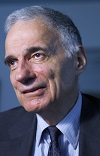Third Parties

Learn about the history of third party participation in U.S. elections.
Sources: Ralph Nader: AP Photo/Jacquelyn Martin; Eugene Debs: AP Photo; Victoria Woodhull: WikiCommons; Theodore Roosevelt: ArtToday; Strom Thurmond: AP Photo; Ross Perot: AP Photo/Shayna Brennan.
| 1832 | For the first time in American history, a third party challenges the major two parties. William Wirt of the Anti-Masonic Party carries 8 percent of the vote and one state. Andrew Jackson, Democratic-Republican, is reelected President over National-Republican Henry Clay. |
| 1848 | Former Democratic President Martin van Buren becomes the presidential candidate of the anti-slavery Free-Soil Party. He wins 10 percent of the popular vote, and is credited with siphoning off enough votes from Democratic candidate Lewis Cass to help Whig candidate Zachary Taylor win the election. |
| 1856 | Democrat James Buchanan defeats Republican John C. Fremont in national elections. Former President Millard Fillmore is selected the presidential candidate of the Know-Nothing or American Party. He wins 22 percent of the popular vote and 8 electoral votes on his anti-Catholic and anti-immigration platform. |
| 1872 | Republican President Ulysses S. Grant defeats Democrat-Liberal Republican Horace Greeley in national elections. Victoria Woodhull is nominated by the Equal Rights Party and becomes the first woman to run for president. African American leader Frederick Douglass is her running mate. |
| 1892 | Former President Grover Cleveland defeats President Benjamin Harrison in national elections. James Weaver of the Populist Party (also called the People’s Party), which is dedicated to agrarian rights, wins 9 percent of the vote and receives 22 electoral votes. Two unrelated political parties, also calling themselves the Progressive Party, participate in presidential elections in 1924 and 1948. |
| 1898 | The Socialist Party is formed. One of its leaders, Eugene Debs, runs for president five times between 1900 and 1920. |
| 1912 | After failing to gain the nomination of his own party, former Republican President Theodore Roosevelt defects, forming the Progressive (or Bull-Moose) party. It is the first time in American history that a third-party candidate receives more votes (electoral and popular) than one of the major two parties. Democrat Woodrow Wilson receives 435 electoral votes, Progressive Roosevelt receives 88, and Republican President William Taft receives 8. |
| 1948 | Democratic President Harry Truman wins the election over Republican Thomas E. Dewey. Many Southern Democrats instead support South Carolina Governor Strom Thurmond as the States’ Rights Party candidate. |
| 1968 | Richard Nixon, a Republican, narrowly defeats Democrat Hubert Humphrey. Many Southern Democrats support Governor George C. Wallace of the American Independent Party instead of Humphrey. |
| 1980 | U.S. Representative John B. Anderson of Illinois loses the Republican nomination for President to Ronald Reagan, who defeats Democratic President Jimmy Carter. Anderson runs as an Independent, and gains 6 percent of the popular vote but no electoral votes. |
| 1992 | Democrat Bill Clinton defeats incumbent Republican President George H. W. Bush. Businessman Ross Perot takes nearly 19% of the vote, siphoning votes from Bush. It was the best showing of a candidate from a minor party since 1927. Following his strong showing, Perot formed the Reform Party. |
| 1996 | Democrat Bill Clinton wins reelection over President Bush. Ross Perot runs as the candidate of the Reform Party and wins 8.4% of the vote. |
| 2000 | Republican George W. Bush wins a disputed election over Democrat Al Gore. Green Party candidate Ralph Nader garners 2.7% of the vote, ballots that may otherwise have been cast for Gore. |
| 2004 | Nader ran as an independent in the 2004 presidential election. He won about 1% of the vote, and his candidacy did not have a major effect on the outcome of the election between George W. Bush and John Kerry.
|





